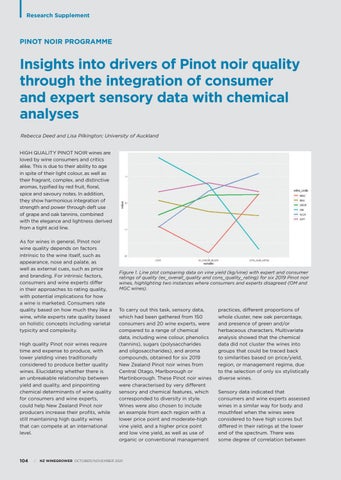Research Supplement
PINOT NOIR PROGRAMME
Insights into drivers of Pinot noir quality through the integration of consumer and expert sensory data with chemical analyses Rebecca Deed and Lisa Pilkington; University of Auckland HIGH QUALITY PINOT NOIR wines are loved by wine consumers and critics alike. This is due to their ability to age in spite of their light colour, as well as their fragrant, complex, and distinctive aromas, typified by red fruit, floral, spice and savoury notes. In addition, they show harmonious integration of strength and power through deft use of grape and oak tannins, combined with the elegance and lightness derived from a tight acid line. As for wines in general, Pinot noir wine quality depends on factors intrinsic to the wine itself, such as appearance, nose and palate, as well as external cues, such as price and branding. For intrinsic factors, consumers and wine experts differ in their approaches to rating quality, with potential implications for how a wine is marketed. Consumers rate quality based on how much they like a wine, while experts rate quality based on holistic concepts including varietal typicity and complexity. High quality Pinot noir wines require time and expense to produce, with lower yielding vines traditionally considered to produce better quality wines. Elucidating whether there is an unbreakable relationship between yield and quality, and pinpointing chemical determinants of wine quality for consumers and wine experts, could help New Zealand Pinot noir producers increase their profits, while still maintaining high quality wines that can compete at an international level.
104 //
Figure 1. Line plot comparing data on vine yield (kg/vine) with expert and consumer ratings of quality (ex_overall_quality and cons_quality_rating) for six 2019 Pinot noir wines, highlighting two instances where consumers and experts disagreed (OM and MGC wines).
To carry out this task, sensory data, which had been gathered from 150 consumers and 20 wine experts, were compared to a range of chemical data, including wine colour, phenolics (tannins), sugars (polysaccharides and oligosaccharides), and aroma compounds, obtained for six 2019 New Zealand Pinot noir wines from Central Otago, Marlborough or Martinborough. These Pinot noir wines were characterised by very different sensory and chemical features, which corresponded to diversity in style. Wines were also chosen to include an example from each region with a lower price point and moderate-high vine yield, and a higher price point and low vine yield, as well as use of organic or conventional management
NZ WINEGROWER OCTOBER/NOVEMBER 2021
practices, different proportions of whole cluster, new oak percentage, and presence of green and/or herbaceous characters. Multivariate analysis showed that the chemical data did not cluster the wines into groups that could be traced back to similarities based on price/yield, region, or management regime, due to the selection of only six stylistically diverse wines. Sensory data indicated that consumers and wine experts assessed wines in a similar way for body and mouthfeel when the wines were considered to have high scores but differed in their ratings at the lower end of the spectrum. There was some degree of correlation between
